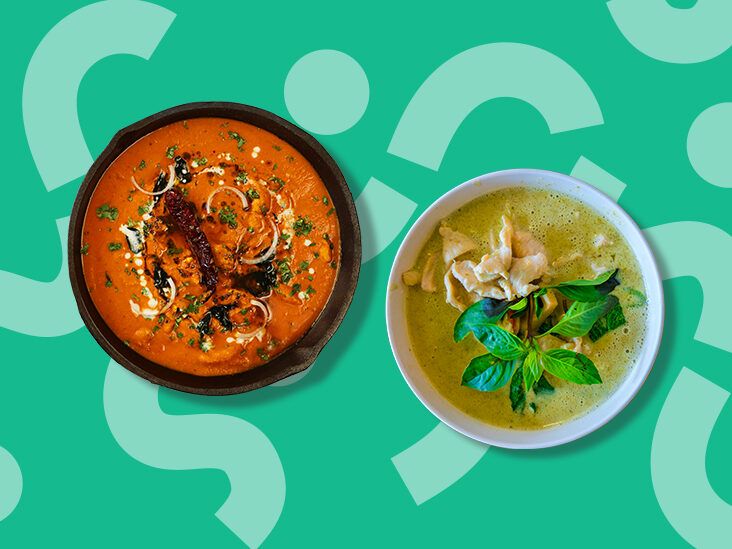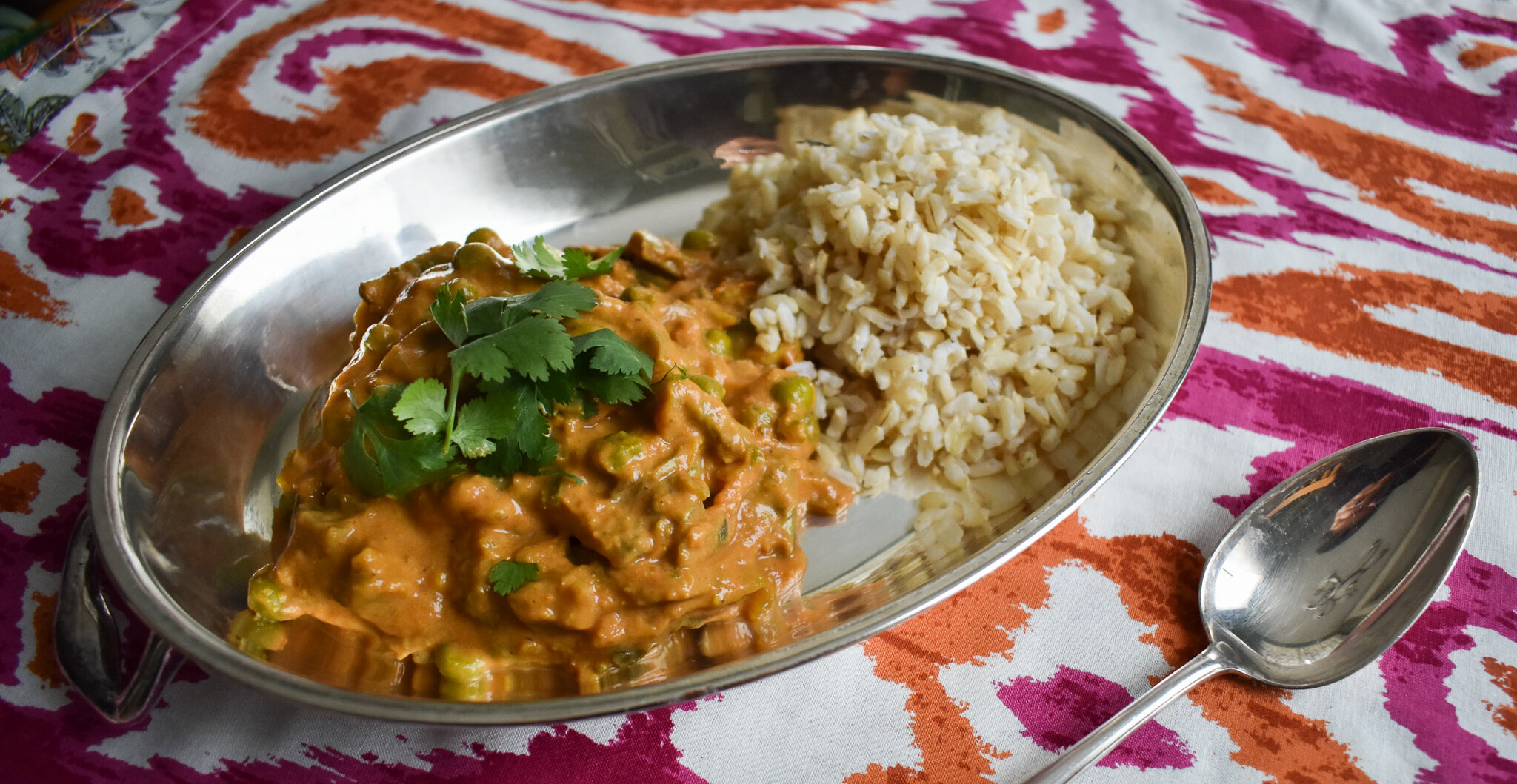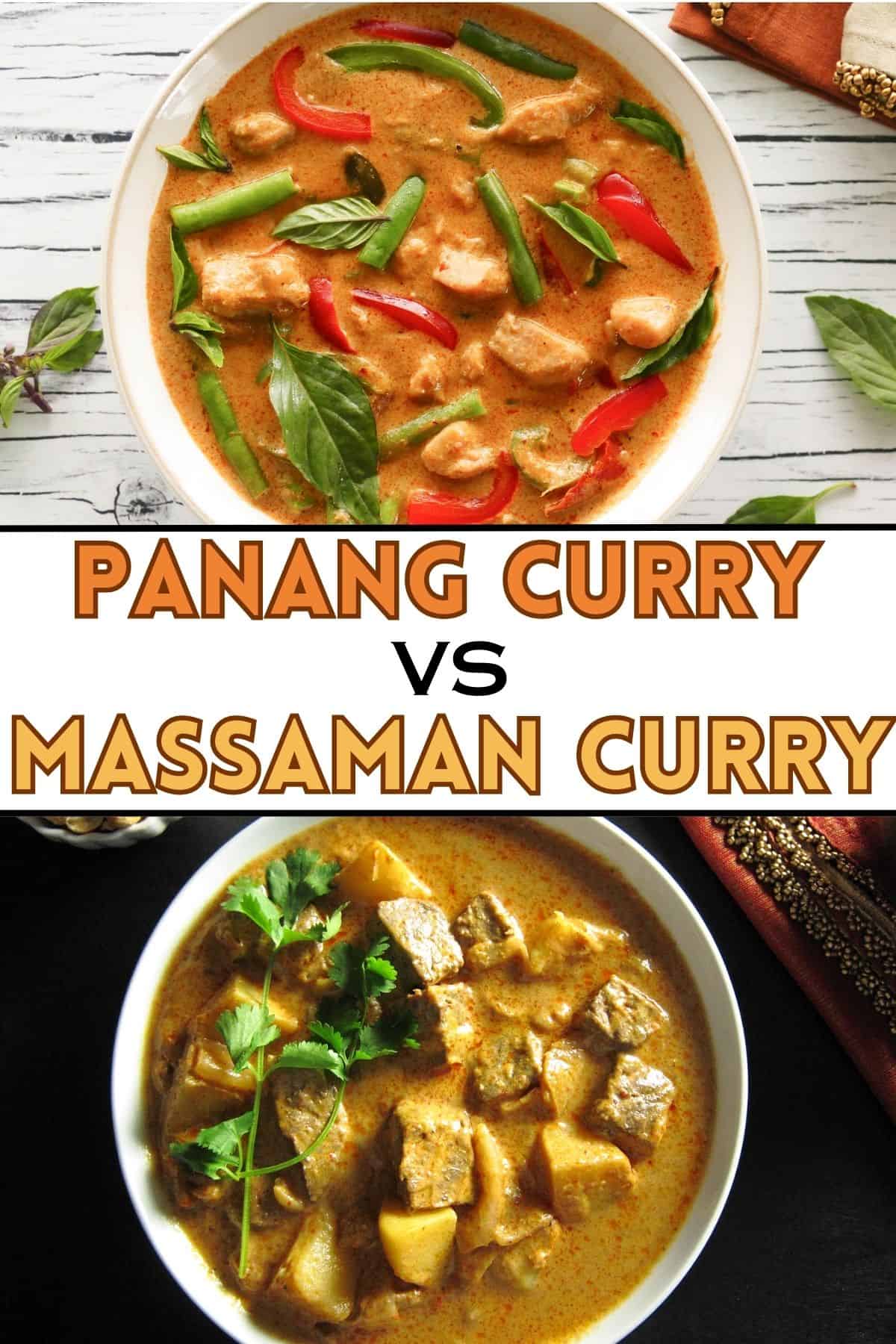
Introduction
In this article, we will delve into the differences between Thai curry and Indian curry. Both dishes are beloved for their aromatic flavors and rich spices, but they have distinct characteristics that make them unique. Whether you prefer the fiery heat of Thai curry or the complex and layered flavors of Indian curry, understanding the disparities between the two can help you choose the perfect option for your palate.
Exploring The Delicious Divide: Thai Curry Vs Indian Curry
What Is Curry And Its Cultural Significance In Both Thailand And India?
Curry is a popular dish that has deep cultural roots in both Thailand and India. It is a culinary tradition that has been passed down through generations, with each region adding its own twists and flavors to the mix. Let’s take a closer look at the key differences between these two mouthwatering cuisines:
Flavor Profile
- Thai curry: Thai curries are known for their bold and vibrant flavors. They often have a perfect balance of sweet, spicy, salty, and sour tastes. Lemongrass, galangal, lime leaves, and Thai basil are commonly used to create the distinctive flavor profile of Thai curries.- Indian curry: Indian curries, on the other hand, offer a more complex and layered flavor experience. They tend to be rich, aromatic, and heavily spiced, with a focus on ingredients like cumin, coriander, turmeric, and garam masala. The flavors can vary greatly depending on the region in India.
Spice Level
- Thai curry: Thai curries are generally spicier than Indian curries. The use of Thai chili peppers and other fiery spices adds a kick of heat that can be intense for those with a low tolerance for spiciness. However, the level of spiciness can be adjusted to suit individual preferences.- Indian curry: While Indian curries can also be spicy, they often offer a broader range of flavors that go beyond just heat. The presence of spices like cinnamon, cardamom, and cloves adds depth and complexity to the dish.
Ingredients
- Thai curry: Thai curries typically include ingredients like coconut milk, fish sauce, shrimp paste, and fresh herbs. The use of fresh ingredients gives Thai curries a light and refreshing taste.- Indian curry: Indian curries often include ingredients like yogurt, cream, tomatoes, and a variety of vegetables or meats. The use of warm spices and slow cooking techniques results in a rich and hearty dish.
In conclusion, while both Thai curry and Indian curry offer an explosion of flavors, they have distinct differences in their flavor profiles, spice levels, and ingredients. Thai curry tends to be spicier and offers a vibrant flavor experience, while Indian curry offers a more nuanced and complex taste. Whichever curry you choose, you are sure to embark on a delicious culinary journey.
Thai Curry: A Burst Of Flavors
The Flavors Of Thai Curry: Sweet, Sour, Spicy, And Salty
Thai curry is known for its bold and vibrant flavors. It offers a perfect balance of sweet, sour, spicy, and salty tastes, creating a culinary masterpiece for your taste buds. The combination of these flavors creates a harmonious explosion of sensations in every bite. Lemongrass, galangal, lime leaves, and Thai basil are commonly used to create the distinctive flavor profile of Thai curry.
Common Ingredients Used In Thai Curry
Thai curry is made using a variety of fresh and fragrant ingredients that contribute to its unique taste. Some common ingredients used in Thai curry include:
- Coconut milk: This creamy ingredient adds a rich and smooth texture to the curry, balancing out the spiciness.
- Fish sauce: Fish sauce, made from fermented fish, adds a savory and umami flavor to the curry, enhancing its overall taste.
- Shrimp paste: Shrimp paste is a salty and flavorful ingredient that adds depth to the curry.
- Fresh herbs: Lemongrass, galangal, and Thai basil are commonly used to infuse the curry with their aromatic and fresh flavors.
- Thai chili peppers: These small, fiery peppers are responsible for the spiciness of Thai curry, adding a kick to the dish.
The combination of these ingredients creates a unique and refreshing flavor that is characteristic of Thai curry.
With its bold and vibrant flavors, Thai curry offers a sensory explosion that is sure to captivate your taste buds. Whether you prefer a milder or spicier curry, this dish has something to offer for everyone. Explore the world of Thai cuisine and indulge in the delightful flavors of Thai curry.
Indian Curry: Rich And Fragrant
The Essence Of Indian Curry: Spice Blends And Layers Of Flavors
The Indian curry is known for its rich and fragrant aroma, as well as its complex blend of spices. The spice blends used in Indian curries typically include turmeric, cumin, coriander, cinnamon, and cardamom, among others. These spices add depth and complexity to the curry, resulting in a flavor explosion in every bite.
Traditional Ingredients Used In Indian Curry
Indian curry employs a wide range of ingredients that contribute to its distinct flavor profile. Here are some common ingredients used in Indian curries:
- Onions and garlic: These aromatic ingredients form the base of many Indian curries, providing a rich and savory flavor.
- Tomatoes: Tomatoes are often used to add tanginess and a hint of sweetness to the curries.
- Ginger and garlic paste: The combination of ginger and garlic adds a strong and pungent flavor to the curry.
- Yogurt or cream: These dairy products lend a creamy and smooth texture to the curry, balancing out the spices.
- Garam masala: This spice blend, made from a combination of ground spices such as cloves, cinnamon, and cardamom, adds warmth and depth of flavor to the curry.
- Fresh herbs: Coriander leaves, mint leaves, and curry leaves are commonly used to garnish Indian curries, adding a fresh and aromatic element.
The combination of these ingredients, along with the careful blending of spices, creates a velvety and thick consistency in Indian curries. The result is a hearty and savory dish that is truly satisfying.
Both Thai and Indian curries offer unique and delicious flavors that cater to different preferences. Whether you favor the bold and vibrant flavors of Thai curry or the rich and fragrant essence of Indian curry, exploring these culinary delights will surely be a delightful experience.
Texture And Consistency: A Clash Of Culinary Styles
Thai Curry: Thin And Vibrant Vs Indian Curry: Thick And Velvety
The texture and consistency of Thai curry and Indian curry are key factors that set them apart. Thai curry is known for its thinner consistency, which allows the flavors to shine through. It has a bright and vibrant taste that feels light on the palate. On the other hand, Indian curry has a velvety and thick consistency. The layers of spices and ingredients create a rich and indulgent experience.
How The Differences In Texture Affect The Overall Dining Experience
The texture of a dish can greatly impact the overall dining experience. In the case of Thai curry, the thin consistency allows the flavors to meld together harmoniously. The lighter texture makes it a refreshing and enjoyable option, especially in hot climates. On the other hand, the thick and velvety texture of Indian curry creates a hearty and fulfilling meal. The richness and complexity of flavors are intensified by the thick consistency, making it a comforting choice.
Whether you prefer the light and bright flavors of Thai curry or the velvety richness of Indian curry, both offer their unique charms. Thai curry serves as a refreshing and vibrant option, highlighting the bold flavors of its ingredients. Indian curry, on the other hand, impresses with its rich and fragrant essence, created by a careful blend of spices and ingredients. Whichever you choose, the journey through these culinary delights will surely be a treat for your taste buds.

Heat Levels: From Mild To Fiery
Thai Curry: Embracing The Fiery Heat
When it comes to heat, Thai curry takes the lead. Known for its bold and intense flavors, Thai curry tends to be hotter and spicier compared to Indian curry. The use of Thai bird’s eye chilies, also known as prik kee noo, adds a fiery kick to Thai curries. These small, potent chilies pack a punch and contribute to the overall heat level of the dish.
Thai curry offers a range of spice levels, from mild to extra spicy. Green curry, with its combination of fresh green chilies, is usually the hottest. Red curry follows closely, while yellow curry tends to be milder. The intensity of Thai curry’s heat is balanced by the vibrant and aromatic flavors of lemongrass, galangal, and kaffir lime leaves.
Indian Curry: A Range Of Heat Intensities To Suit Different Palates
Indian curry, on the other hand, offers a wider range of heat intensities to suit different palates. While some Indian curries can be mild and creamy, others can be fiery hot. The heat in Indian curries comes from a combination of spices such as red chili powder, black pepper, and dried chilies.
Indian curry allows you to adjust the heat level according to your preference. For those who prefer milder flavors, dishes like Butter Chicken or Chicken Korma can be a great choice. These dishes have a creamy and mild taste with a hint of spice. On the other end of the spectrum, dishes like Vindaloo or Madras curry offer a fiery heat that will satisfy the spice lovers.
Indian curry also offers a variety of spice blends, such as garam masala, that contribute to the unique flavors and heat levels. The combination of spices and the cooking techniques used in Indian cuisine create a depth of flavor that is sought after by many.
Overall, whether you prefer the intense kick of Thai curry or the varied heat levels of Indian curry, both offer a delightful culinary experience. The level of heat in each curry can be adjusted to suit individual preferences, allowing everyone to enjoy the flavors and spices in their own way. So, get ready to embark on a spice-filled adventure and discover the heat that excites your taste buds.
Regional Variations: Diving Into Diversity
Thai Curry: Red, Green, Yellow, And More
Thai curry offers a wide variety of flavors and colors, with red, green, and yellow being the most popular options. Each color represents a different combination of ingredients and flavors.
Red Curry:
- Spicy and aromatic
- Made with red chili paste, garlic, lemongrass, and other herbs and spices
- Usually made with meat, such as chicken or beef, but can also be vegetarian
- Rich and creamy due to the addition of coconut milk
Green Curry:
- Hottest of the three
- Made with green chili paste, cilantro, basil, and other aromatic herbs
- Meat options include chicken, beef, and seafood
- The heat is balanced by the freshness of the herbs and the creaminess of coconut milk
Yellow Curry:
- Milder compared to red and green curry
- Yellow in color due to the addition of turmeric
- Flavor profile includes turmeric, cumin, coriander, and other spices
- Can be made with various proteins, including chicken, shrimp, or tofu
Indian Curry: Punjabi, Bengali, And South Indian Specialties
Indian curry is known for its regional variations, each offering unique flavors and cooking techniques. Some popular regional curries include:
Punjabi Curry:
- Rich and hearty
- Uses a tomato-based sauce and a blend of spices like garam masala
- Common proteins include chicken, lamb, and paneer
- Popular dishes include Butter Chicken and Chicken Tikka Masala
Bengali Curry:
- Light and aromatic
- Made with mustard oil and a blend of spices like fenugreek and nigella seeds
- Common proteins include fish and vegetables
- Popular dishes include Fish Curry and Shorshe Ilish (Hilsa fish curry)
South Indian Curry:
- Spicy and flavorful
- Uses ingredients like coconut, tamarind, and curry leaves
- Common proteins include seafood, chicken, and lentils
- Popular dishes include Chicken Chettinad and Fish Curry
With such a wide range of flavors and regional specialties, both Thai curry and Indian curry offer a diverse and exciting culinary experience. Whether you prefer the bold and fiery heat of Thai curry or the nuanced flavors of Indian curry, there is something for everyone to enjoy in these delicious dishes.
Serving Styles: Rice Or Bread?
Thai Curry: Served With Fragrant Jasmine Rice
Thai curry is traditionally served with fragrant jasmine rice, which complements the flavors of the curry. Jasmine rice is known for its delicate aroma and soft texture, making it the perfect accompaniment to the spicy and aromatic Thai curry.
Indian Curry: Accompanied By Naan, Roti, Or Rice
Indian curry offers more flexibility in terms of serving options. While basmati rice is a popular choice, Indian curry can also be enjoyed with various types of bread. The most well-known bread option is naan, which is a soft and fluffy bread usually made with white flour and topped with garlic or butter. Other popular bread options include roti, which is a whole wheat flatbread, and paratha, which is a layered and flaky bread.
In addition to bread, Indian curry can also be served with rice, similar to Thai curry. Basmati rice is commonly used due to its fragrant and long grains, which provide a perfect base for soaking up the flavors of the curry. Whether you prefer the combination of bread and curry or the classic pairing of rice and curry, both options offer a delicious and satisfying meal.
It’s important to note that while Thai curry is typically enjoyed with jasmine rice, Indian curry can be enjoyed with a variety of bread and rice options, allowing for more culinary diversity and personal preference.

Popular Dishes: Curry Showdown
Thai Curry: Green Curry, Red Curry, And Massaman Curry
Thai curry is known for its rich and vibrant flavors, which come from a combination of herbs and spices such as lemongrass, galangal, and Thai basil. There are several types of Thai curry, including green curry, red curry, and massaman curry:
- Green curry: Made with green chilies, Thai basil, and kaffir lime leaves, green curry is known for its spicy and aromatic flavor profile. It is often made with chicken or beef, but can also be made with seafood or tofu for a vegetarian option.
- Red curry: Made with red chilies, red curry paste, and coconut milk, red curry has a slightly milder and sweeter taste compared to green curry. It is commonly made with chicken or beef, but can also be made with pork or shrimp.
- Massaman curry: Considered a more mild and fragrant curry, massaman curry combines Thai and Indian flavors. It is made with a blend of spices such as cinnamon, cloves, and cardamom, along with coconut milk, potatoes, and peanuts. Massaman curry is often made with beef, but can also be made with chicken or lamb.
Indian Curry: Butter Chicken, Tikka Masala, And Rogan Josh
Indian curry is incredibly diverse and varies greatly from region to region. There are countless types of Indian curry, but some popular ones include butter chicken, tikka masala, and rogan josh:
- Butter chicken: Known for its creamy and buttery tomato-based sauce, butter chicken is a crowd favorite. It is made with marinated chicken cooked in a rich and flavorful gravy.
- Tikka masala: Another well-known Indian curry, tikka masala is made with marinated chicken (or paneer for a vegetarian option) cooked in a spiced tomato-based sauce. It has a slightly tangy and creamy taste.
- Rogan josh: Hailing from Kashmir, rogan josh is a slow-cooked curry made with tender pieces of lamb or goat. It is known for its rich and aromatic flavors, with spices such as ginger, garlic, and fennel.
These are just a few examples of the wide range of curries found in Indian cuisine. Each curry has its own unique combination of spices and ingredients, resulting in a variety of flavors and textures. Whether you prefer the bold and spicy Thai curries or the rich and aromatic Indian curries, both cuisines have something delicious to offer.
Conclusion
Comparing Thai Curry And Indian Curry: It’s All About Personal Preference
After exploring the main differences between Thai curry and Indian curry, it is clear that both cuisines offer unique and delicious flavors. The choice between the two ultimately comes down to personal preference. Thai curry is known for its rich and vibrant flavors, with options like green curry, red curry, and massaman curry. These curries feature a combination of herbs and spices that create a spicy and aromatic taste experience. On the other hand, Indian curry offers a diverse range of flavors, with popular dishes like butter chicken, tikka masala, and rogan josh. These curries vary in ingredients and spices, resulting in rich and aromatic flavors.
Factors To Consider When Choosing Your Curry Flavor Journey
When deciding between Thai curry and Indian curry, there are a few factors to consider:
- Spice level: Thai curry tends to be spicier than Indian curry, so if you enjoy bold and fiery flavors, Thai curry may be the way to go. Indian curry, on the other hand, offers a range of spice levels, allowing you to choose a milder or hotter option based on your preference.
- Flavor profile: Thai curry is known for its unique combination of lemongrass, galangal, and Thai basil, resulting in a distinct and refreshing flavor profile. Indian curry, with its wide range of spices and ingredients, offers a more complex and layered taste experience.
- Protein options: Both Thai and Indian curries can be made with a variety of proteins, such as chicken, beef, seafood, or tofu. Consider your preferred protein when choosing your curry as it can significantly impact the overall flavor and texture of the dish.
In the end, whether you choose Thai curry or Indian curry, both cuisines offer a delightful culinary adventure. It’s all about personal preference and exploring different flavors and textures. So go ahead and embark on your curry flavor journey to discover the tastes that suit your palate.
FAQ: Thai Curry vs Indian Curry: Exploring the Delicious Divide
Q: What is the main difference between Thai curry and Indian curry?
A: The main difference lies in the flavor profiles and ingredients used. Thai curry tends to be lighter and has a prominent use of fresh herbs, such as lemongrass, galangal, and Thai basil. Indian curry, on the other hand, is rich and complex with a blend of spices that give each dish its own distinct identity.
Q: Are the spices used in Thai curry and Indian curry the same?
A: While both Thai and Indian curries feature a variety of spices, they differ in terms of the specific spices used. Thai curries often rely on ingredients like turmeric, coriander, and cumin, whereas Indian curries make use of spices like garam masala, turmeric, cumin, and cardamom. The spice combinations contribute to the unique taste profiles of each cuisine.
Q: Which cuisine is spicier, Thai or Indian?
A: While both cuisines can be spicy, Indian curries are generally considered to be hotter in terms of spice levels. Thai curries, on the other hand, offer a balanced blend of flavors that include spice, but are not overwhelmingly hot. However, the spiciness can be adjusted based on personal preference in both Thai and Indian cuisines.
Q: What are the popular types of Thai curries?
A: Thai cuisine is known for its diverse range of curries. Some popular types of Thai curries include Green Curry (Kaeng Khiao Wan), Red Curry (Kaeng Phet), Yellow Curry (Kaeng Kari), and Massaman Curry. These curries differ in terms of color, spice levels, and ingredients used, creating a wide array of flavors to enjoy.
Q: What are the popular types of Indian curries?
A: Indian cuisine has an extensive repertoire of curries, each with its own regional specialties. Popular Indian curries include Butter Chicken, Tikka Masala, Rogan Josh, Vindaloo, and Korma. These curries vary in spice levels, ingredient combinations, and cooking methods, showcasing the diverse culinary traditions across India.
Q: What are the main ingredients used in Thai curry?
A: The main ingredients in Thai curry include coconut milk, fresh herbs (such as lemongrass, galangal, and Thai basil), shrimp paste, fish sauce, and a variety of vegetables and proteins such as chicken, beef, or tofu. These ingredients work together to create the distinct and aromatic flavors found in Thai curries.
Q: What are the main ingredients used in Indian curry?
A: Indian curries often feature a base of onions, tomatoes, garlic, and ginger. The spice palette includes a blend of garam masala, turmeric, cumin, coriander, and chili powder. Indian curries commonly include proteins like chicken, lamb, or paneer (Indian cottage cheese), along with a variety of vegetables. The use of ghee (clarified butter) is also prevalent in Indian cooking.
Q: Can dietary preferences and restrictions be accommodated in Thai and Indian curries?
A: Both Thai and Indian curries can accommodate a range of dietary preferences and restrictions. Many Thai curries can easily be made vegetarian or vegan by substituting proteins with tofu or vegetables. Indian curries also offer options for vegetarians, vegans, and those with gluten-free or lactose-free diets. However, it is always best to check with the restaurant or chef to ensure that your specific dietary needs are met.
Q: Are there any regional variations within Thai and Indian curries?
A: Yes, both Thai and Indian curries exhibit a wide range of regional variations. In Thailand, different regions have their unique curry styles, such as the milder and creamier curries of the central region, or the spicier curries of the south. Similarly, Indian curries vary greatly across different states and even within particular regions, showcasing the diverse culinary traditions and local ingredients found throughout India.
In summary, Thai and Indian curries, though sharing some common elements, possess distinct flavor profiles and ingredient combinations. Both cuisines offer a sensory adventure with their unique spices, aromas, and mouthwatering tastes. Exploring the differences and similarities between these delectable dishes is a culinary journey worth embarking upon!

We are a small takeaway restaurant offering a great selection of food cooked by our Thai chef. Table spaces are limited, so please book in advance.